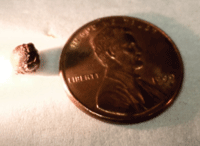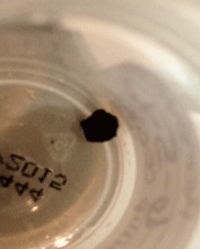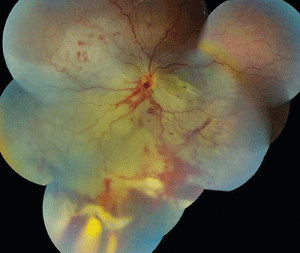Acute injury caused by a metallic foreign body is a relatively common ocular emergency. Such insults often are caused by the use of bench grinders, masonry chisels or even explosive devices.

The BB following removal from our patient’s right eye.
However, some of the most potentially devastating foreign body injuries result from an impact with a high-velocity projectile, such as an air-propelled BB. Ocular trauma resulting from a BB wound is an emergent clinical situation that requires rapid resolution.
Here, we examine a case study of a young boy who presented with a BB gun injury that occurred nearly eight months earlier.
History
A 12-year-old white male presented for a routine eye examination on April 1, 2009. This was the child’s first eye examination at an optometry office.
The patient’s social and medical histories were normal. His family ocular history was positive for glaucoma (maternal grandfather). The patient’s mother indicated that he took 10mg Adderall (amphetamine and dextroamphetamine, Teva Pharmaceuticals) for attention deficit hyperactivity disorder.
Diagnostic Data
As is common among school-aged children, he reported difficulty reading the blackboard in class. His uncorrected entering visual acuity measured 20/60 O.D. and 20/50 O.S. Upon pinhole testing, his
acuity improved to 20/20- O.U.
The anterior segment exam was normal, with a white eye and no discomfort. Extraocular muscles were intact, and the patient had orthophoria at both far and near. The cornea was clear, and the anterior chamber and lens were within normal limits. Dilated fundus examination revealed no pathology and a 0.40 x 0.40 cup-to-disc ratio O.U.
We gave him a spectacle prescription of -2.25 sphere O.D. and -1.50 + 0.25D x 160 O.S., which yielded a final acuity of 20/20 O.U. We then scheduled the patient for a yearly follow-up examination.
First Follow-up Examination
The patient returned for a routine follow-up examination on June 5, 2012 and stated that he was not having any problems with his eyes. However, his mother noted that he had a small “bump” under his right eye that was painful to the touch. Since the last visit, he and his family moved out of the state, but had just recently returned to the area.
Uncorrected visual acuity measured 20/100 O.D. and 20/60 O.S. The patient didn’t bring his most recent spectacles or the prescription. External examination revealed a small, 4mm bump located under his right eye near the maxillary rim. At first glance, this presentation appeared to be a chalazion. But then both the patient and his mother informed me that he was “shot in the right eye” with a BB gun in October 2011.
His mother asked if the BB could still be in his eye. I informed her that, if in fact it were still in there, he would have had an inflammatory reaction and pain. When I pulled his lower eyelid downward, I found a mucopurulent discharge in the inferior fornix with a brown tinge. Typically, bacterial discharge is yellow, white or green, so this finding was somewhat unusual.

The BB in a specimen cup.
The patient was becoming uncomfortable secondary to the prying down of his eyelid. Nonetheless, I thought I saw a brown object located in the lower cul-de-sac. After the instillation of several more anesthetic drops, I asked one of the other doctors, Craig McCabe, M.D., to assist me with the external examination. We inserted a moistened cotton swab into the lower cul-de-sac and pushed the BB out of the inferior fornix.
The inferior conjunctiva was irritated and exhibited a rust-colored area approximately 5mm in diameter. The remainder of the examination was normal, with comparable physical findings to those observed at the initial examination.
We prescribed a neomycin/polymixin B/dexamethasone drop and instructed the patient to taper the dosage over the next two weeks. We updated his spectacle prescription to -2.00 + 0.25D x 015 O.D. and -1.50 + 0.75D x 160 O.S., which yielded a final acuity of 20/20 O.U.
We scheduled the patient for a two-week follow-up to determine if the conjunctiva healed properly. We decided that if he had any residual problems upon return, we would schedule the patient for a conjunctival resection.
Second Follow-up Exam
Our patient returned on June 21, 2012 for follow-up to determine if he required a conjunctival resection to remove damaged tissue. He was compliant with his medication and tapered the dosage appropriately. His eye was white, with no sign of trauma. His best-corrected visual acuity measured 20/20 O.U. His pupils were equally round and reactive to light and accommodation. Additionally, his cornea appeared clear, and he reported no distress or ill effects. Most importantly, the inferior palpebral conjunctiva appeared normal.
Discussion
The history of our patient’s BB injury was of great interest. In early October 2011, while living out of state, our patient was in the backyard jumping on a trampoline. His friend was shooting a BB gun at several cans on a wooden fence. Evidently, a BB had ricocheted off the fence and hit the patient in the right eye.
According to the patient and his mother, a “scan or x-ray” was completed at the ER to rule out an ocular foreign body before he saw a local eye doctor. Then, the eye doctor evaluated the patient. He reported that the boy had a conjunctival abrasion and a subconjunctival hemorrhage in the right eye. Additionally, he documented a clear cornea as well as an uncomplicated fundus appearance. The eye doctor prescribed Tobradex (tobramycin and dexamethasone, Alcon) t.i.d. O.D.
Further Discussion
The 1983 film “A Christmas Story” tells the story of a boy who yearns for a BB gun for Christmas. And although Santa Claus cautions young Ralphie that “You’ll shoot your eye out,” this movie does not adequately depict the dangerous nature of these weapons, which many adults consider to be toys.
Between 1990 and 2000, there were 39 non-powder, gun-related deaths reported in the U.S.1 Non-powder guns continue to cause serious injuries to both children and adolescents.1 Persistent in this problem is a lack of medical recognition that BB guns can, in fact, cause very serious injuries, including penetration of the ocular globe.1
In most states, BB guns may be purchased at major retail stores by anyone 18 years of age or older. However, no additional safety requirements or restrictions exist (e.g., obtaining a permit or completing a training course).
Air guns are designed to fire several different forms of ammunition, including plastic pellets, metal BBs and metal pellets (0.177 caliber). Most modern BB guns are designed with spring-loaded, compressed air or CO2 cartridge propulsion systems that are capable of firing projectiles at velocities of up to 1,200ft/s—fast enough to cause significant bodily harm and/or death.2 (As a point of comparison, the average muzzle velocity of a standard 0.22 caliber long rifle rimfire bullet is approximately 1,150ft/s.3) Specifically, research has shown that even slower projectile velocities of 246ft/s have a 50% chance of penetrating the ocular globe.4

Our patient was extremely fortunate. Many ocular BB injuries result in choroidal rupture, full-thickness macular hole formation or sclopetaria (as seen here).
The incidence of air-powered, gun-related eye injury in the United States has declined somewhat between 1993 and 2002.5 Nevertheless, the potential for severe vision damage is extremely high. One study indicated that young, black males are at the greatest risk for air-powered, gun-related eye injury.5 Air-powered projectile insults can cause hyphema, corneal contusion, corneal abrasion, traumatic iritis, commotion retinae and traumatic mydriasis.6 Following such injuries, entering visual acuity may range from 20/15 to light perception.6
Damage to the eye and surrounding structures from a BB projectile can be quite devastating. By far, perforating injuries are the most serious potential insult, potentially resulting in complete visual compromise.7 But, besides the immediate need to remove these metallic foreign bodies, this type of injury can even threaten human life.8
There are several documented cases when an intraocular BB resulted in an embolus and subsequent monocular blindness.9 Imaging always should be performed to determine if the object penetrated the orbit. While many types of imaging are used in modern medicine, x-rays are preferred in this case because no magnets are used.
The overall percentage of patients who require surgical involvement following this type of injury is 10%.10 However, our patient was extremely fortunate that intraocular involvement did not occur in this case.
Dr. Simon has been practicing optometry for more than 20 years and is currently a staff member at the McCabe Vision Center in Murfreesboro, Tenn.
1. Laraque D. Injury risk of nonpowder guns. Pediatrics. 2004 Nov;114(5):1357-61.
2. Naude GP, Bongard FS. From deadly weapon to toy and back again: the danger of air rifles. J Trauma. 1996 Dec;41(6):1039-43.
3. Winchester Ammunition. 22 Long Rifle 40 Grain: Ballistics Information. Available at:
www.winchester.com/Products/rimfire-ammunition/Performance/super-x-rimfire/Pages/XT22LR.aspx. Accessed September 24, 2012.
4. Powley KD, Dahlstrom DB, Atkins VJ, Fackler ML. Velocity necessary for a BB to penetrate the eye: an experimental study using pig eyes. Am J Forensic Med Pathol. 2004 Dec;25(4):273-5.
5. McGwin G Jr, Hall TA, Xie A, Owsley C. Gun-related eye injury in the United States, 1993-2002. Ophthalmic Epidemiol. 2006 Feb;13(1):15-21.
6. Ramstead C. Ocular injuries associated with Airsoft guns: a case series. Can J Ophthalmol. 2008 Oct;43(5):584-7.
7. Ahmadabadi MN, Karkhaneh R, Valeshabad AK, et al. Clinical presentation and outcome of perforating ocular injuries due to BB guns: a case series. Injury. 2011 May;42(5):492-5.
8. Stepniewski W, Mówiński G, Sokół W. Experimental biological effect of the gunshot wound inflicted by type BB 4,5 cartridges fired from an A-101 pneumatic pistol. Arch Med Sadowej Kryminol. 2006 Oct-Dec;56(4):223-7.
9. Pacio CI, Murphy MA. BB embolus causing monocular blindness in a 9-year-old boy. Am J Ophthalmol. 2002 Nov;134(5):776-8.
10. Ho VH, Wilson MW, Fleming JC, Haik BG. Retained intraorbital metallic foreign bodies. Ophthal Plast Reconstr Surg. 2004 May;20(3):232-6.

